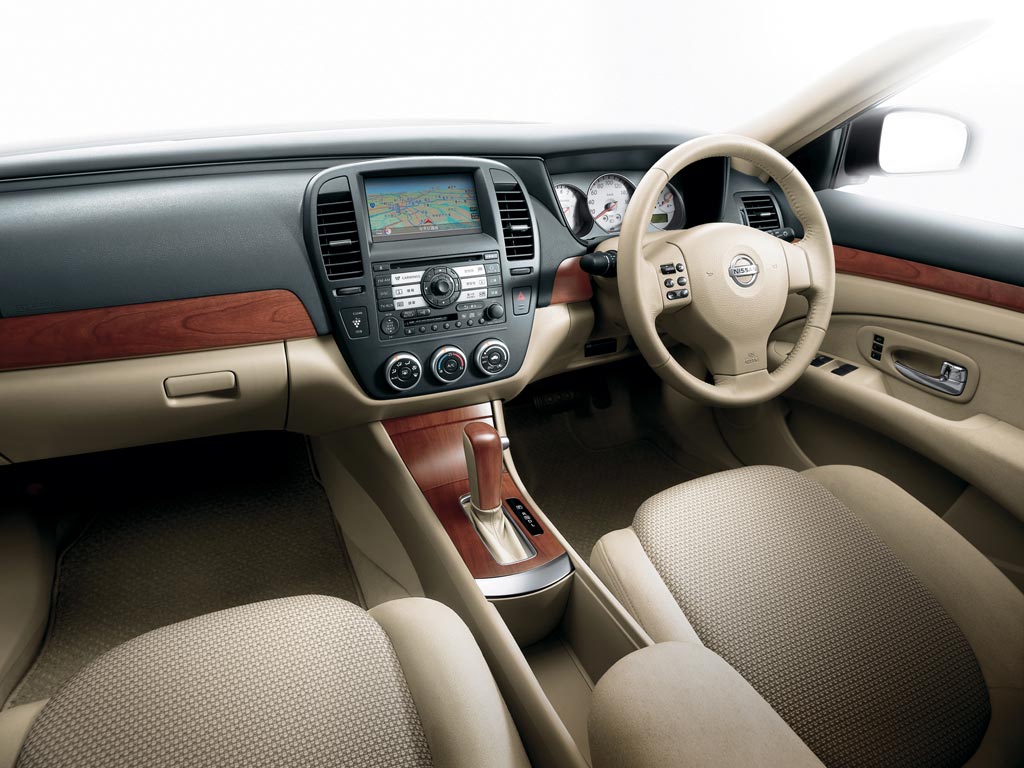Check the interior
Check power windows, locks and other accessories
 Test power windows, power locks and mirrors. Window regulator problems are common in many older cars. Sometimes a window goes down well, but goes up very slow or crooked. Test power windows, power locks and mirrors. Window regulator problems are common in many older cars. Sometimes a window goes down well, but goes up very slow or crooked. |
 Problems with heated seats are very common and a heated element could be quite expensive to replace. Test both seats. Problems with heated seats are very common and a heated element could be quite expensive to replace. Test both seats. |
 Check all the controls, including the audio system. If the car has a CD player or AUX / USB input, check if it works. Check all the controls, including the audio system. If the car has a CD player or AUX / USB input, check if it works. |
Check the heater and airconditioner functions
 Make sure to test the air conditioner; air conditioner problems are common in used cars. With the engine running, turn the A/C on. You should feel cold air coming from the vents soon after the A/C is turned on. Make sure to test the air conditioner; air conditioner problems are common in used cars. With the engine running, turn the A/C on. You should feel cold air coming from the vents soon after the A/C is turned on.
Test all the heater fan speed settings; it’s a common problem when the heater fan works only at high speed settings. Watch out for musty or other odors from the vents. A burnt oil smell from the vents indicate possible oil leaks from the engine. An atifreeze smell is a sign of a problem too. |
 If the vehicle has the rear heater/AC controls, make sure everything works there too. If the vehicle has the rear heater/AC controls, make sure everything works there too. |
Check vehicle manufacturer’s label
 Check the manufacturer’s label; usually you can find it on the driver’s door or on the door jamb. Besides the VIN number that you might need to check the history records, the label contains the manufacturing date. The manufacturing date is different from the model year. For example, the model year of this car is 1997, but as you can see, it was assembled in August 1996. Another 1997 car could be assembled in June 1997, which would be a better choice all else being equal. Check the manufacturer’s label; usually you can find it on the driver’s door or on the door jamb. Besides the VIN number that you might need to check the history records, the label contains the manufacturing date. The manufacturing date is different from the model year. For example, the model year of this car is 1997, but as you can see, it was assembled in August 1996. Another 1997 car could be assembled in June 1997, which would be a better choice all else being equal. |
Look for signs of flood damage
 Flash floods are common these days. If a car has been flooded, it’s more likely to develop various electrical problems in the future. Modern cars have many electronic components under the floor carpet and around the foot wells that can get damaged if submerged under water. Flash floods are common these days. If a car has been flooded, it’s more likely to develop various electrical problems in the future. Modern cars have many electronic components under the floor carpet and around the foot wells that can get damaged if submerged under water.
This car in the photo has been flooded during a heavy rain. You still can see the water level mark in the speaker cover. Look for signs of moisture under the carpet. Check the trunk and the spare tire well for signs of water damage. A history report can also reveal flood damage. Be suspicious if the history report indicates that the car came from the flood area. |
Check spare tire, jack and lug nut wrench
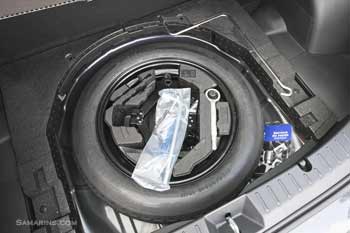 Check if the car has the spare tire and the jack. If the wheels have wheel locks installed, make sure there is the key for the wheel locks. Check if the car has the spare tire and the jack. If the wheels have wheel locks installed, make sure there is the key for the wheel locks. |
Visual inspection under the hood
Before checking anything under the hood, make sure the engine is off, the transmission is in Park and the parking brake is applied. A quick look under the hood can tell a lot about the car. What to look for:
• Leaks
• Smell of burnt oil or antifreeze
• Anything that suggests that a car has not been regularly serviced
• Signs of poor quality repairs
• Mods that suggest the car has been raced or otherwise abused
It’s worth noting that if the car looks clean and shiny under the hood, it doesn’t yet mean that there could be no leaks or other problems. Often dealers shampoo the engine compartment before putting the car up for sale. That’s why before buying, you still should arrange for a mechanical inspection by an independent mechanic, so he or she can lift the car and inspect it for leaks and other issues from underneath.
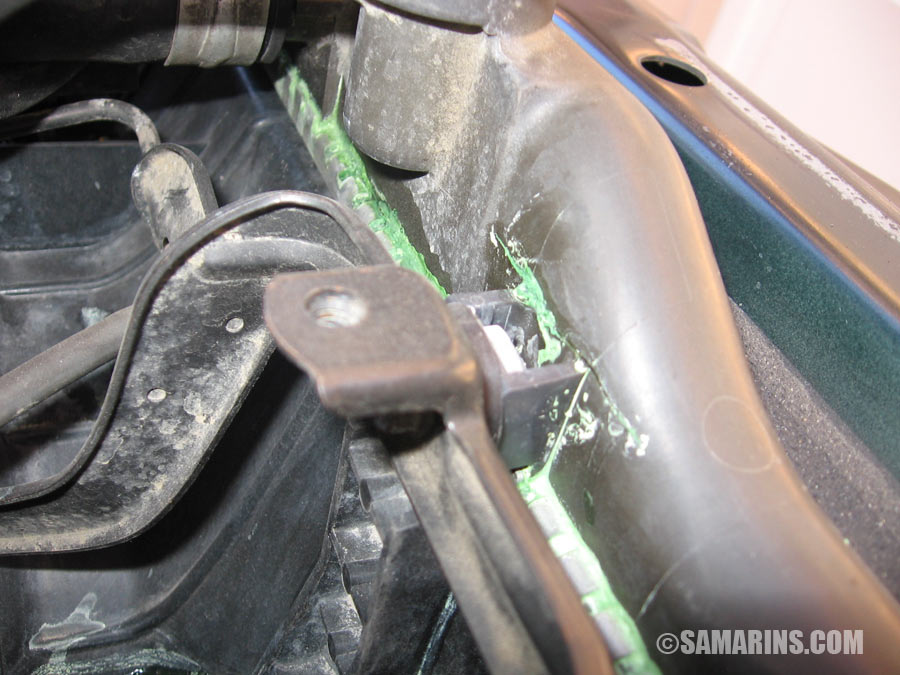 Minor leaks are fairly common in high-mileage cars, but all else being equall, you are better off with the car that has no leaks at all. In addition, leaks (coolant leaks especially) could point to more serious problems. This car, for example, has a coolant leak from a small crack in the radiator. The engine runs fine, however, upon further mechanical inspection, we found that the head gasket started leaking in this car. A head gasket repair is very expensive. Look for leaks under the car; the only thing that should be dripping from under the car is water from the air conditioner drain tube when the A/C is running. The A/C drain tube is typically located under the passenger side of the firewall. Any other leak (coolant, engine oil, transmission fluid, etc.) points to a problem. The smell of burnt oil or antifreeze under the hood is another indication of possible leaks. Minor leaks are fairly common in high-mileage cars, but all else being equall, you are better off with the car that has no leaks at all. In addition, leaks (coolant leaks especially) could point to more serious problems. This car, for example, has a coolant leak from a small crack in the radiator. The engine runs fine, however, upon further mechanical inspection, we found that the head gasket started leaking in this car. A head gasket repair is very expensive. Look for leaks under the car; the only thing that should be dripping from under the car is water from the air conditioner drain tube when the A/C is running. The A/C drain tube is typically located under the passenger side of the firewall. Any other leak (coolant, engine oil, transmission fluid, etc.) points to a problem. The smell of burnt oil or antifreeze under the hood is another indication of possible leaks. |
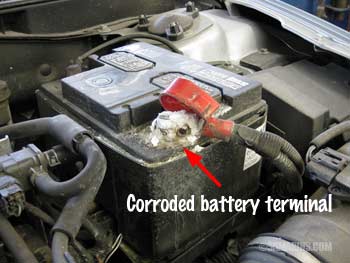 The battery terminal in this car is badly corroded. Not only this car needs a new battery and probably a new battery cable, this suggests that this car probably hasn’t been serviced regularly. The battery terminal in this car is badly corroded. Not only this car needs a new battery and probably a new battery cable, this suggests that this car probably hasn’t been serviced regularly. |
 Here is another example: this bolt clearly looks out of place in this car (click on the image to see larger view). There supposed to be an engine mount in this place, but it’s missing in this Toyota. This obviously doesn’t look like a high-quality repair. Here is another example: this bolt clearly looks out of place in this car (click on the image to see larger view). There supposed to be an engine mount in this place, but it’s missing in this Toyota. This obviously doesn’t look like a high-quality repair. |
Check the engine oil level and condition
 If you are uncomfortable with these these tests, leave them for your mechanic. Make sure the engine is off and the parking brake is applied. Find the engine oil dipstick (usually it has a bright handle that says” Engine Oil.” Pull the dipstick out and check the oil level and condition. If the oil looks very dirty and the oil level is very low, it means that either the engine consumes oil, or it has been poorly maintained. Check the condition of the dipstick itself; if it’s covered with black deposits, it’s also a sign of poor maintenance. If you are uncomfortable with these these tests, leave them for your mechanic. Make sure the engine is off and the parking brake is applied. Find the engine oil dipstick (usually it has a bright handle that says” Engine Oil.” Pull the dipstick out and check the oil level and condition. If the oil looks very dirty and the oil level is very low, it means that either the engine consumes oil, or it has been poorly maintained. Check the condition of the dipstick itself; if it’s covered with black deposits, it’s also a sign of poor maintenance. |
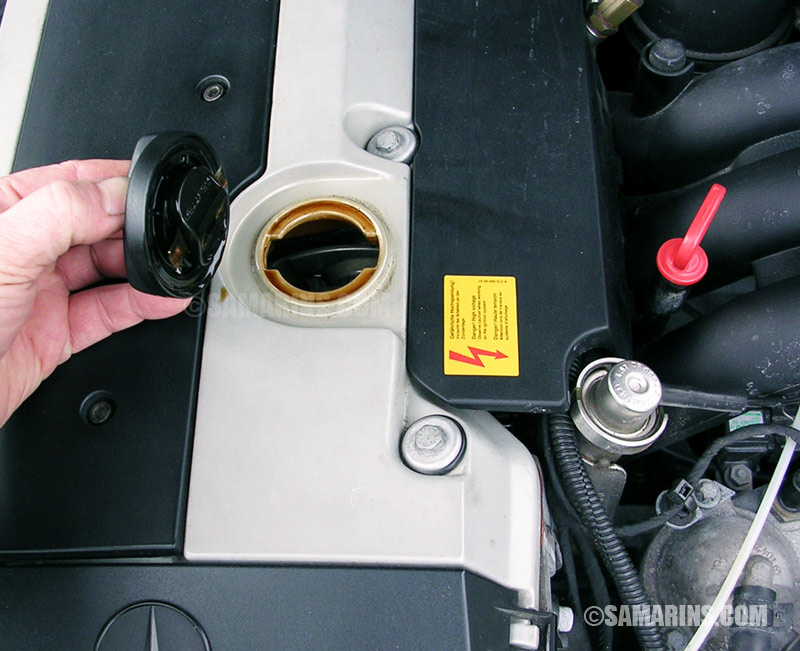 With the engine off, open the oil filler cap and look inside the engine; use your flashlight. If the internal engine parts that you can see are covered with thick black deposits, it’s also an indication of poor engine condition. With the engine off, open the oil filler cap and look inside the engine; use your flashlight. If the internal engine parts that you can see are covered with thick black deposits, it’s also an indication of poor engine condition. |
Check transmission fluid
 If you can find the transmission fluid dipstick (not all cars have one), check the transmission fluid condition. To see better, drop some fluid on a white paper towel. Transmission fluid should be clean and transparent. Very dirty transmission fluid that has a burnt smell is a sign of excessive transmission wear. If you can find the transmission fluid dipstick (not all cars have one), check the transmission fluid condition. To see better, drop some fluid on a white paper towel. Transmission fluid should be clean and transparent. Very dirty transmission fluid that has a burnt smell is a sign of excessive transmission wear. |
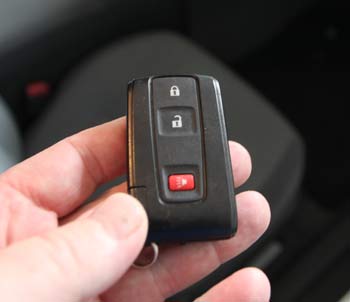 Test if both keyfobs work. Typically a new car comes with two or three keys or key fobs; ask how many come with the car.
Test if both keyfobs work. Typically a new car comes with two or three keys or key fobs; ask how many come with the car.
 Check the condition of the seats, look for burnt marks and other damage. Minor damage can be repaired, ask if the dealer can arrange for the repairs. Check the condition of the seat belts.
Check the condition of the seats, look for burnt marks and other damage. Minor damage can be repaired, ask if the dealer can arrange for the repairs. Check the condition of the seat belts. Rear wiper is another part that often has problems in older cars. Test all wipers and washer functions.
Rear wiper is another part that often has problems in older cars. Test all wipers and washer functions. Test power windows, power locks and mirrors. Window regulator problems are common in many older cars. Sometimes a window goes down well, but goes up very slow or crooked.
Test power windows, power locks and mirrors. Window regulator problems are common in many older cars. Sometimes a window goes down well, but goes up very slow or crooked. Problems with heated seats are very common and a heated element could be quite expensive to replace. Test both seats.
Problems with heated seats are very common and a heated element could be quite expensive to replace. Test both seats. Check all the controls, including the audio system. If the car has a CD player or AUX / USB input, check if it works.
Check all the controls, including the audio system. If the car has a CD player or AUX / USB input, check if it works. Make sure to test the air conditioner; air conditioner problems are common in used cars. With the engine running, turn the A/C on. You should feel cold air coming from the vents soon after the A/C is turned on.
Make sure to test the air conditioner; air conditioner problems are common in used cars. With the engine running, turn the A/C on. You should feel cold air coming from the vents soon after the A/C is turned on. If the vehicle has the rear heater/AC controls, make sure everything works there too.
If the vehicle has the rear heater/AC controls, make sure everything works there too. Check the manufacturer’s label; usually you can find it on the driver’s door or on the door jamb. Besides the VIN number that you might need to check the history records, the label contains the manufacturing date. The manufacturing date is different from the model year. For example, the model year of this car is 1997, but as you can see, it was assembled in August 1996. Another 1997 car could be assembled in June 1997, which would be a better choice all else being equal.
Check the manufacturer’s label; usually you can find it on the driver’s door or on the door jamb. Besides the VIN number that you might need to check the history records, the label contains the manufacturing date. The manufacturing date is different from the model year. For example, the model year of this car is 1997, but as you can see, it was assembled in August 1996. Another 1997 car could be assembled in June 1997, which would be a better choice all else being equal. Flash floods are common these days. If a car has been flooded, it’s more likely to develop various electrical problems in the future. Modern cars have many electronic components under the floor carpet and around the foot wells that can get damaged if submerged under water.
Flash floods are common these days. If a car has been flooded, it’s more likely to develop various electrical problems in the future. Modern cars have many electronic components under the floor carpet and around the foot wells that can get damaged if submerged under water.
 Check if the car has the spare tire and the jack. If the wheels have wheel locks installed, make sure there is the key for the wheel locks.
Check if the car has the spare tire and the jack. If the wheels have wheel locks installed, make sure there is the key for the wheel locks. Minor leaks are fairly common in high-mileage cars, but all else being equall, you are better off with the car that has no leaks at all. In addition, leaks (coolant leaks especially) could point to more serious problems. This car, for example, has a coolant leak from a small crack in the radiator. The engine runs fine, however, upon further mechanical inspection, we found that the head gasket started leaking in this car. A head gasket repair is very expensive. Look for leaks under the car; the only thing that should be dripping from under the car is water from the air conditioner drain tube when the A/C is running. The A/C drain tube is typically located under the passenger side of the firewall. Any other leak (coolant, engine oil, transmission fluid, etc.) points to a problem. The smell of burnt oil or antifreeze under the hood is another indication of possible leaks.
Minor leaks are fairly common in high-mileage cars, but all else being equall, you are better off with the car that has no leaks at all. In addition, leaks (coolant leaks especially) could point to more serious problems. This car, for example, has a coolant leak from a small crack in the radiator. The engine runs fine, however, upon further mechanical inspection, we found that the head gasket started leaking in this car. A head gasket repair is very expensive. Look for leaks under the car; the only thing that should be dripping from under the car is water from the air conditioner drain tube when the A/C is running. The A/C drain tube is typically located under the passenger side of the firewall. Any other leak (coolant, engine oil, transmission fluid, etc.) points to a problem. The smell of burnt oil or antifreeze under the hood is another indication of possible leaks. The battery terminal in this car is badly corroded. Not only this car needs a new battery and probably a new battery cable, this suggests that this car probably hasn’t been serviced regularly.
The battery terminal in this car is badly corroded. Not only this car needs a new battery and probably a new battery cable, this suggests that this car probably hasn’t been serviced regularly. Here is another example: this bolt clearly looks out of place in this car (click on the image to see larger view). There supposed to be an engine mount in this place, but it’s missing in this Toyota. This obviously doesn’t look like a high-quality repair.
Here is another example: this bolt clearly looks out of place in this car (click on the image to see larger view). There supposed to be an engine mount in this place, but it’s missing in this Toyota. This obviously doesn’t look like a high-quality repair. If you are uncomfortable with these these tests, leave them for your mechanic. Make sure the engine is off and the parking brake is applied. Find the engine oil dipstick (usually it has a bright handle that says” Engine Oil.” Pull the dipstick out and check the oil level and condition. If the oil looks very dirty and the oil level is very low, it means that either the engine consumes oil, or it has been poorly maintained. Check the condition of the dipstick itself; if it’s covered with black deposits, it’s also a sign of poor maintenance.
If you are uncomfortable with these these tests, leave them for your mechanic. Make sure the engine is off and the parking brake is applied. Find the engine oil dipstick (usually it has a bright handle that says” Engine Oil.” Pull the dipstick out and check the oil level and condition. If the oil looks very dirty and the oil level is very low, it means that either the engine consumes oil, or it has been poorly maintained. Check the condition of the dipstick itself; if it’s covered with black deposits, it’s also a sign of poor maintenance. With the engine off, open the oil filler cap and look inside the engine; use your flashlight. If the internal engine parts that you can see are covered with thick black deposits, it’s also an indication of poor engine condition.
With the engine off, open the oil filler cap and look inside the engine; use your flashlight. If the internal engine parts that you can see are covered with thick black deposits, it’s also an indication of poor engine condition. If you can find the transmission fluid dipstick (not all cars have one), check the transmission fluid condition. To see better, drop some fluid on a white paper towel. Transmission fluid should be clean and transparent. Very dirty transmission fluid that has a burnt smell is a sign of excessive transmission wear.
If you can find the transmission fluid dipstick (not all cars have one), check the transmission fluid condition. To see better, drop some fluid on a white paper towel. Transmission fluid should be clean and transparent. Very dirty transmission fluid that has a burnt smell is a sign of excessive transmission wear.
